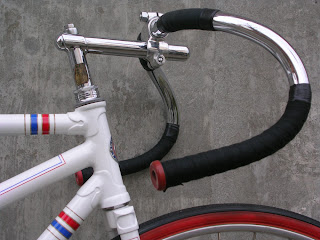While riding with a friend yesterday, I chanced upon this gem:
To say it's in rough shape is to be kind: It looks like it was fished from the bottom of the river. But it was probably a very nice bike of its type in its time, and could be so again today with lots of TLC.
I noticed this chainguard before I noticed the rest of the bike. In a strange way, it's baroque, art deco and modernist all at once. I'm guessing that it was chromed before turning into rust; if it was, it would have really been something to behold!
In addition to a major overhaul and refinishing, the bike needs a seat. It also might need a skirt guard. At least, I'm assuming that was the reason for the holes in the fenders.
Is this an ancestor of today's suspension systems? Or maybe it just adds to the bike's aura of invincibility.
As you may be able to discern from the headbadge, the bike is a Schwinn. From what I could see, I guessed it's from the 1930's or 1940's. I wonder whether the bike originally came with the "holey" fender. For all I know, Schwinn ladies' bikes from that time might have had skirt guards.
But the surprises didn't end with the bike:
Now, where do you think I was? The Brooklyn Botanical Gardens?
Actually, I wasn't very far from the Gardens. But this place is nothing like the Gardens:
Believe it or not, Flatbush Falls (what I decided to call them) is, as you can see, in front of an apartment building. (It's at the corner of East 16th Street and Avenue I in Brooklyn. Of course, stopping to look at it was a dead give-away that I'm not from the neighborhood. Actually, even if I hadn't stopped, I would have stood out in that neighborhood--which is home to thousands of Orthodox Jews--bceause of the bike I was riding and the way I was dressed.
Tosca's a great bike. But she's definitely not one someone in that neighborhood would ride. Nor, for that matter, is the Schwinn I saw.
To say it's in rough shape is to be kind: It looks like it was fished from the bottom of the river. But it was probably a very nice bike of its type in its time, and could be so again today with lots of TLC.
I noticed this chainguard before I noticed the rest of the bike. In a strange way, it's baroque, art deco and modernist all at once. I'm guessing that it was chromed before turning into rust; if it was, it would have really been something to behold!
In addition to a major overhaul and refinishing, the bike needs a seat. It also might need a skirt guard. At least, I'm assuming that was the reason for the holes in the fenders.
Is this an ancestor of today's suspension systems? Or maybe it just adds to the bike's aura of invincibility.
As you may be able to discern from the headbadge, the bike is a Schwinn. From what I could see, I guessed it's from the 1930's or 1940's. I wonder whether the bike originally came with the "holey" fender. For all I know, Schwinn ladies' bikes from that time might have had skirt guards.
But the surprises didn't end with the bike:
Now, where do you think I was? The Brooklyn Botanical Gardens?
Actually, I wasn't very far from the Gardens. But this place is nothing like the Gardens:
Believe it or not, Flatbush Falls (what I decided to call them) is, as you can see, in front of an apartment building. (It's at the corner of East 16th Street and Avenue I in Brooklyn. Of course, stopping to look at it was a dead give-away that I'm not from the neighborhood. Actually, even if I hadn't stopped, I would have stood out in that neighborhood--which is home to thousands of Orthodox Jews--bceause of the bike I was riding and the way I was dressed.
Tosca's a great bike. But she's definitely not one someone in that neighborhood would ride. Nor, for that matter, is the Schwinn I saw.











































